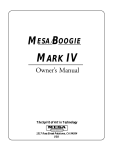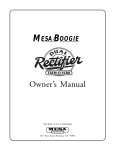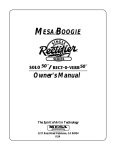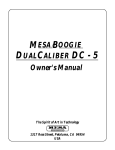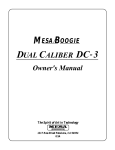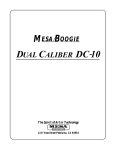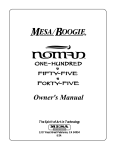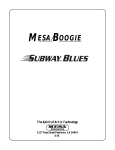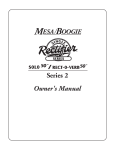Download Mesa/Boogie Heartbreaker Owner`s manual
Transcript
MESA BOOGIE Owner’s Manual The Spirit of Art in Technology 1317 Ross Street Petaluma, CA 9495 USA Hello from the Tone Farm... YOU, the smart player and all around intuitive human, have put your trust in us to be your amplifier company. This is something we do not take lightly. Our reward is that we’ve made a classic amplifier and by choosing this amplifier, you have become part of the Mesa family...Welcome! Our goal is to never let you down. Your reward is that you are now the owner of an amp bred of fine all tube amp heritage...benefiting from the many patented pioneering Mesa/Boogie circuits that led to the refinement of your new instrument. Feel confident, as we do, this amp will inspire many hours of musical satisfaction and lasting enjoyment. It was built with you in mind, by players who know the value of a fine musical instrument and the commitment it takes to make great music. The same commitment to quality, value and support we make to you...our new friend. TABLE OF CONTENTS Precautions ___________________________________________________________ Page # A Little History ______________________________________________________________ 1 Overview: Pre-Amp - Power-Up - To Operate - Power - Instant Gratification _____ 2, 3 &4 FRONT PANEL: VOLUME ___________________________________________________________________ 5 TREBLE ___________________________________________________________________ 5 MIDDLE ____________________________________________________________________ 5 BASS _____________________________________________________________________ 6 MASTER __________________________________________________________________ 6 CHANNEL & MODE CONTROL________________________________________________ 6 VOICING SWITCHES _________________________________________________________ 7 LEVEL CONTROL GENDER SWITCH ________________________________________________________ 7&8 REAR PANEL: FUSE _____________________________________________________________________ 8 POWER CORD RECEPTACLE ________________________________________________ 9 POWER SOURCE __________________________________________________________ 9 RECTIFIER SELECT _____________________________________________________ 9&10 BIAS SELECT _____________________________________________________________ 10 EFFECTS: Send and Return _________________________________________________ 10 REVERB FOOTSWITCH ____________________________________________________ 10 PRESENCE CONTROL _____________________________________________________ 11 REVERB CONTROLS ______________________________________________________ 11 POWER SELECT 100 / 60 WATTS _____________________________________________ 11 SLAVE CONTROL _________________________________________________________ 12 SPEAKERS________________________________________________________________ 12 SAMPLE SETTING and PERSONAL SETTINGS PAGE _______________________ 13 & 14 TUBE TASK CHART ________________________________________________________ 15 DIAGNOSING TUBE PROBLEMS _____________________________ 16, 17 , 18, 19 and 20 PARTS SHEET _____________________________________________________________ 21 Your MESA/Boogie Amplifier is a professional instrument. Please treat it with respect and operate it properly. USE COMMON SENSE AND ALWAYS OBSERVE THESE PRECAUTIONS: Do not expose amplifier to moisture, rain or water, direct sunlight or extremely high temperatures. Always insure that amplifier is properly grounded. Always unplug AC power cord before changing fuse or any tubes. When replacing fuse, use only same type and rating. Avoid direct contact with heated tubes. Insure adequate air circulation behind amplifier. Keep amplifier away from children. Be sure to connect to an AC power supply that meets the power supply specifications listed on the rear of the unit. If there is any danger of lightning occurring nearby, remove the power plug from the wall socket in advance. To avoid damaging your speakers and other playback equipment, turn off the power of all related equipment before making the connections. Do not use excessive force in handling control buttons, switches and controls. Remove the power plug from the AC mains socket if the unit is to be stored for an extended period of time. Do not use solvents such as benzene or paint thinner to clean the unit. Wipe off the exterior with soft cloth. YOUR AMPLIFIER IS LOUD! EXPOSURE TO HIGH SOUND VOLUMES MAY CAUSE PERMANET HEARING DAMAGE! No user serviceable parts inside. Refer service to qualified personnel. Always unplug AC power before removing chassis. EXPORT MODELS: Always insure that unit is wired for proper voltage. Make certain grounding conforms with local standards. READ AND FOLLOW INSTRUCTIONS OF PROPER USAGE. A Little History...Congratulations on your choice of the HEARTBREAKER as your amplifier! Its fine all-tube heritage is apparent in each soulful note you play, but you may not be aware that this amplifier was created as the 25th anniversary tribute to the amp that put Mesa/Boogie on the map and changed guitar amplification forever...the Boogie. The Mark I Boogie burst on the scene in late 1970 as the first amplifier ever to contain a high gain pre-amplifier that could be overdriven at any output volume. By ingeniously using a cascading series of pre-amp stages, Randall Smith brought to life the (until then) latent potential of the 12AX7 and changed the sound of electric guitar. No longer would the saxophone be the most likely instrument to grab the solo spotlight...now guitar had a singing voice! With its liquid sustain and bold authority, the early Mark I immediately won the hearts of the worlds’ top players and was soon an international smash hit. Overwhelmed by orders for this compact, high performance 1x12 giant killer, Randall made plans to leave the store he had co-founded, (Prune Music,) where he had been modifying and repairing amps (for the stars of the Bay Area’s music scene) and move the operation into a converted shack behind his house. In this shack in the mountains north of San Francisco, every part of these first Boogies were made by hand! The chassis was formed, circuit boards were etched, front panels were silk screened and the first exotic hardwood and rare snakeskin cabinets were made...all with relentless attention to detail. Mesa Engineering was now in full swing with world wide acclaim. High gain was born back then and seemed to be here to stay, as proven when the Mark II’s introduced the world to channel switching in late ’78. The next important development came in 1986 when Mesa pioneered the first Tri-Modal footswitchable amplifier, the Mark III. The rest of the amplifier world soon followed suit. Now, the Mark IV’s offer fully expanded footswitchability...and high gain, multi mode, channel switching amps are everywhere. The many innovations (seen for the first time) included on these early Mark I’s have since become standard features on virtually all major brand amplifiers of today. All these modern amps have a common ancestor in the original Boogie...the missing link between vintage (one sound) and modern high gain, footswitching (multi sound) amplifiers. The HEARTBREAKER assembles all these early innovations (along with many more recent ones) and showcases them in a 2 channel, 5 mode footswitching package that pays ultimate tribute to the soulful voice of these vintage Mark I Boogies. Enough history for now...we thought you might find your new HEARTBREAKERS’ lineage interesting - and possibly give you a sense of pride knowing that its bloodline figures prominently into amplifier history. FRONT VIEW HEARTBREAKER CH 2 CH 1 * * ON LUST LOVE ON HI GAIN CH 1 INPUT LO HI SWITCH HI MODE HI MODE TRIM VOLUME FAT TREBLE BOOST! MIDDLE CH 2 ALL HI MODE GAIN BASS LO MASTER HI & LO BOLD TRIM NORMAL VOLUME TREBLE FAT MIDDLE BRIGHT BASS CURVACEOUS WARM STANDBY POWER LEVEL MASTER REAR VIEW HEARTBREAKER WARNING: Unplug power before replacing fuse or removing bolts mounting chassis. 117 V. 3 A. 60 HZ. 1.5 A FUSE 3 A SB Replace USE 6V6's WITH TWEED POWER fuse with AND TUBE RECTIFIER ONLY same type VACUUM FULL and rating TUBE NORMAL only. BIAS SETTING MUST MATCH TUBES IN USE! 100 WATTS SPEAKERS 6L6 6v6 6L6 6v6 PRESENCE CH2 REVERB SEND RETURN TWEED VARIAC SILICON DIODES POWER SOURCE RECTIFIER SELECT EL34 EL34 PRESENCE CH1 REVERB 8 OHM SLAVE REVERB FOOT SWITCH 60 WATTS BIAS SELECT PAGE 1 16 OHM 2x12 COMBO 4 OHM Overview: Before we get to the specific channels and their individual controls, let’s go over the HEARTBREAKER’S layout and features. CH 2 CH 1 * ON * LUST LOVE ON HI GAIN CH 1 INPUT LO HI SWITCH HI MODE TRIM VOLUME TREBLE HI MODE CH 2 FAT BOOST! NORMAL MIDDLE BASS MASTER ALL TRIM LO HI & LO HI MODE GAIN VOLUME TREBLE FAT BRIGHT MIDDLE BASS BOLD CURVACEOUS WARM MASTER STANDBY POWER LEVEL THE PRE-AMP: Part of the HEARTBREAKERS’ beauty lies in its simplicity. Yet as you look closer and start to use its many faces, you will realize it is an amazing collection of vintage style amps living under one roof. Contained in its two friendly channels, LOVE and LUST, a mere five controls per, invite you to explore the most soulful and identifiable guitar circuits you’ve ever heard. It’s all in here...from the twangiest tweed to the bubbliest black face; from the most collectible plexi to the liquid black magic of those coveted early Boogies. There are two ways to access the different channels of the HEARTBREAKER, either via the channel select footswitch (included) when it is connected to the front panel footswitch jack, or manually by using the front panel channel select toggle switch. You will notice a vertical row of three mini toggle switches that divide the two channels near the center of the front panel. These switches access the two channels and their two gain stages, “HI” and “LO”. The top switch travels left to right and toggles between Channel 1 (LOVE) and Channel 2 (LUST.) CH 2 CH 1 * * LUST LOVE HI The center and lower switches operate up and down and toggle between the “HI” and “LO” gain stages. The GAIN CH 1 center switch commands LOVE (Channel 1), while the lower switch regulates LUST (Channel 2.) Now let’s LO HI power up so that we can move on to the individual channels and their respective controls. CH 2 GAIN LO POWER-UP: First remove the protective covers from the tubes (plastic webbing) before connecting the A.C. cord to a power receptacle. Connect your favorite guitar to the instrument Input jack. Turn the power switch “ON” while leaving the STANDBY switch set to “STANDBY.” (It is always a good idea to practice this start up procedure as at least 30 seconds of warm-up time lessens the shock on cold power tubes, thus prolonging their life substantially.) Next, using the example below as a guide, set the controls as illustrated. Now turn the STANDBY switch to the “ON” position, listen to the two distinctly different channels using now either the footswitch or the channel select toggle switch as mentioned in the paragraph above. CH 2 CH 1 ON * * ON LUST LOVE HI GAIN CH 1 INPUT LO HI SWITCH HI MODE TRIM VOLUME TREBLE HI MODE FAT BOOST! MIDDLE BASS CH 2 ALL HI MODE GAIN TRIM NORMAL MASTER LO VOLUME TREBLE BOLD HI & LO FAT BRIGHT MIDDLE BASS WARM LEVEL CURVACEOUS STANDBY POWER THE PRE-AMP SECTION: Channel 1 (LOVE) is smooth and warm, wired to capture all the patriotic spirit of the greatest American guitar circuits. Its tone controls move from up front in the “LO” (Rhythm) mode - to the rear in the two “HI” (Lead) modes (NORMAL and BOOST), making LOVE the sweeter of the two channels for bright clean sounds or spanking high headroom chording. Due to gain structure and tone control placement, LOVES’ “HI” mode is capable of handling higher front end (VOLUME) settings. When searching for blistering, high gain solo sounds, the BOOST mode would likely be the best choice. The NORMAL mode of LOVES’ “HI” circuit is great for the more focused, lower gain, blues sounds. PAGE 2 TO OPERATE: (Continued) both of the channels offer a TRIM / FAT voicing switch for the “HI” mode that enables you to either let the guitars’ natural character come through the gain unaltered or, fortify it with a little warm gain for a smoother lead voice. The LUST channel incorporates a BRIGHT / WARM switch that allows you to either scoop the midrange a little for sweeter vintage style clean sounds and increased headroom or, thicken up the sauce for a warmer clip when pushing the “LO” mode for soloing or going for more girth in the “HI” mode. After deciding on the sound you wish to use in each channel and you have set the desired balance between the two channels with each MASTER control, you can use the LEVEL control located on the right side of the front panel to adjust the overall playing level of the entire amplifier. This allows you to adjust for different rooms without having to alter your individual channels once you have found your sound. Each channel has its own dedicated PRESENCE and REVERB controls which are located near the center of the rear panel and are stacked vertically per channel. When reaching from the front of the unit for these controls, the PRESENCE is located on top (nearest to the top of the cabinet) and the REVERB control for that same channel is directly below it. When viewing the HEARTBREAKER from the front, the REVERB and PRESENCE controls for Channel 1 (LOVE) are to the left (closest to the INPUT jack) and the two controls for Channel 2 (LUST) are to the right (closest to the power ON/OFF switch.) Within the first few hours of ownership of the HEARTBREAKER you may find yourself groping around a bit for these two controls, but you will quickly learn to dial these with finesse without ever having to look at them...especially the PRESENCE which becomes easy to dial on the fly after you’ve logged a few hours on the amplifier. Aside from striving to keep internal lead lengths to toneful minimum, placing these less used controls on the rear panel enabled us to keep the front panel simple to operate and stay true to the more vintage era character to which the HEARTBREAKER pays tribute. REAR VIEW HEARTBREAKER 1.5 A WARNING: Unplug power FUSE before replacing fuse or removing bolts mounting 3 A SB chassis. 117 V. 3 A. 60 HZ. USE 6V6's WITH TWEED POWER Replace AND TUBE RECTIFIER ONLY fuse with same type VACUUM FULL and rating NORMAL TUBE only. BIAS SETTING MUST MATCH TUBES IN USE! 100 WATTS SPEAKERS 6L6 6v6 6L6 6v6 PRESENCE SEND RETURN TWEED VARIAC SILICON DIODES POWER SOURCE RECTIFIER SELECT EL34 EL34 PRESENCE CH2 CH1 REVERB REVERB 60 WATTS BIAS SELECT 8 OHM SLAVE REVERB FOOT SWITCH 4 OHM 16 OHM 2x12 COMBO THE POWER: The HEARTBREAKER starts with a 100 Watt (mono) power amp that boasts our patented Switchable Rectifiers (Tube or Solid State) which alters the whole character of the attack from either springy and compressed - to dynamic and forward. This versatile power section can also accommodate either 4 x 6V6 power tubes (Use Tweed Power Only) - producing roughly 40 watts) - or - the Bias may be set via the rear panel switch to properly run 2 x EL34 (recommend 5U4G Rectifier Tube) or 4 x EL34 (with the standard 5AR4 Recto Tube in place), giving you your choice of approximately 45 or 90 watts respectively, of a more Euro style power personality. The aforementioned Tweed Power switch works as a built in Variac, letting you choose between the standard 117 volt operation - and a looser, more vintage 93 volt setting. Finally, a master “Power Voicing” feature appears as the Gender switch found on the right side of the front panel. “BOLD” and “CURVACEOUS” reveal two distinct and opposite mannerisms. “BOLD” brings the sound forward, enhancing dynamic response and increasing headroom substantially. “CURVACEOUS” scoops the sound and produces a more vintage voice with increased elasticity apparent at the strings thus adding an extra element of emotion, soul and feel you will need when your out to invoke tears with your tone. PAGE 3 OTHER FEATURES: An effects loop has been fitted to the HEARTBREAKER to provide for interfacing of outboard signal processors. This loop occurs electronically between the pre-amp and power section of the amplifier. This is one of the most crucial stages in any integrated amplifier and the integrity of the sound may be adversely altered here quite easily by using less than premium quality outboard gear. Due to the extreme sensitivity of this point in the signal path in any of the high performance tube amplifiers we build, we recommend you try the amplifier with the processor you wish to interface with before you purchase it...in case the processor in question is mismatched in either impedance and / or sonic quality. NOTE: The HEARTBREAKER is a high end professional musical instrument dedicated to delivering the purest tube tone possible. We spared no expense to assure the integrity of its all tube design and cannot accept responsibility for the degradation of its tone due to the interfacing of compromising outboard gear. The HEARTBREAKER is fitted with a SLAVE jack and LEVEL control located on the right side of the rear panel (when viewing the unit from the rear). This feature allows you to capture the sound of both the pre-amp and power section when using the unit in a multiple amp rig where external signal processors are fed from several amp sources and then sent to a common power amplifier and set of speakers. NOTE: The SLAVE jack is not a tuned recording output or cabinet simulator and should not be used as such. The HEARTBREAKER 2x12 Combo packs two of our custom designed Celestion 90 watt 12" speakers for faithful reproduction of the sweet retro-minded tone. Both Combo and Head versions can accommodate a wide variety of extension cabinets and speaker impedance loads by using some combination of the four available speaker output jacks found on the left side of the rear panel. (1 x 16, 1 x 8 and 2 x 4 ohm taps are provided) INSTANT GRATIFICATION: CH 2 CH 1 * * ON LUST LOVE ON HI GAIN CH 1 INPUT LO HI SWITCH HI MODE HI MODE TRIM VOLUME TREBLE CH 2 FAT NORMAL BOOST! MIDDLE BASS MASTER ALL HI MODE GAIN TRIM LO VOLUME TREBLE HI & LO FAT BRIGHT MIDDLE BASS BOLD CURVACEOUS WARM MASTER STANDBY POWER LEVEL Example 1: Channel 1: “LO” : Clean Rhythm Channel 2: “HI”: Honey Lead Rear Panel: Full Power, Tube Rectifier, 100 watt PRESENCE: Channel 1 = 3:00 - 5:00 Channel 2: = 1:00 - 3:30 REVERB: Dial to taste per Channel CH 2 CH 1 * * ON LUST LOVE ON HI GAIN CH 1 INPUT LO HI SWITCH HI MODE HI MODE TRIM VOLUME TREBLE FAT BOOST! MIDDLE BASS NORMAL MASTER CH 2 LO ALL HI MODE GAIN TRIM VOLUME TREBLE HI & LO FAT MIDDLE BOLD BRIGHT BASS MASTER Example 2: Channel 1: “HI” - Boost: Burning Lead Channel 2: “LO”: Vintage Clean Rear Panel: Full Power, Tube Rectifier, 100 watt PRESENCE: Channel 1 = 9:00 - 10:30 Channel 2: = 5:00 - 7:00 REVERB: Dial to taste per Channel PAGE 4 CURVACEOUS WARM LEVEL STANDBY POWER At this point we would like to encourage you to take a break and enjoy your new amplifier for a bit. Give it a good test run and see what 25 years of Tone can sound and feel like. And when you return, beaming from the ride, we’ll be ready to get more specific with the channels and the individual controls. So ‘till then...Enjoy ! And once again, we appreciate you trusting us with your tone. Thank you for choosing us to be your amplifier company...Welcome to the Mesa/Boogie Family ! FRONT PANEL & CONTROLS: VOLUME: Like most amplifiers, the VOLUME (front end gain) control in each channel determines it’s sensitivity and overall tonal characteristics. It meters the amount of gain that your guitar signal will produce. In the HEARTBREAKER, we paid special attention to the amount and frequencies of gain present in each mode, making sure the whole range of available gain is musically usable. We also worked diligently with our suppliers to develop pots with tapers useful to players that require a touch sensitive relationship of input signal level - to gain saturation...an essential ingredient to a great amps’ expressive nature. To maximize your musical expression, spend some time learning the different reINPUT gions of gain in each mode and the tonal colors that they enhance. Almost more - or certainly equal to the tone SWITCH controls, the VOLUME control shapes your sound. VOLUME TREBLE: As with most guitar amplifiers, the TREBLE control is the strongest of the three rotary tone controls. Its setting on the HEARTBREAKER determines the blend and strength of the MIDDLE and BASS controls. Set high, it is the dominant control, thus minimizing the amount of MID and BASS that would be possible in the mix. Set low, the TREBLE becomes the recessive control and a warmer, darker blend is produced. Dial with care. Subtle tweaking of this control tends to produce the best results. INPUT SWITCH TRIM VOLUME TREBLE MIDDLE: Your new HEARTBREAKER uses a unique midrange circuit that not only blends in rich warm midrange, but goes beyond to give you an added bonus. Through endless daily tone dreaming, the “if-only” design dictum led to the dial-in-gain boost MIDDLE control. In the HEARTBREAKER another great pushed sound was made possible by the inclusion of a dual purpose MID, which is built into Channel 1’s MID control. INPUT INPUT SWITCH SWITCH HI MODE TRIM VOLUME FAT TREBLE MIDDLE If this still isn’t crazy enough for you...Max the VOLUME and TREBLE controls and set the PRESENCE control to and plug the HEARTBREAKER into a 4x12 with some Celestion Vintage 30’s or 25’s. The versatility that this dual purpose MID control lends to Channel 1’s “LO” gain mode greatly expands its usefulness as both a clean and overdrive channel. INPUT SWITCH HI MODE TRIM VOLUME TREBLE to about the taper is adjusted to act as a very effective MID control. As you From increase the MID to and above, you will hear the lower MIDS getting more pronounced and fatter. At about the MID leaves behind the old notion of being a tone control and becomes a truly usable gain control. This upper range is a smokin’ addition to Channel 1’s VOLUME control for all kinds of higher gain rhythm sounds. Try the MID set high and the VOLUME control at about for a cool blues solo sound. FAT MIDDLE PAGE 5 FRONT PANEL & CONTROLS: (Continued) BASS: This control blends in the lower frequencies and its effectiveness, again, depends on the setting of the TREBLE control. It should be set with moderation as extreme settings in either low or high directions can produce an unbalanced tone. Be “especial ly” especially careful when using higher VOLUME settings in either channel. Too much BASS will cause a flabby unfocused sound that can’t be dialed out because excessive BASS has been introduced to the pre-amp in the early stages. Try setting the BASS to for clean sounds in the “LO” modes and or below when dialing up pushed sounds in either channel. In the “HI” modes of either channel, try setting the BASS somewhere between and . INPUT INPUT SWITCH SWITCH HI MODE TRIM VOLUME FAT TREBLE MIDDLE HI MODE BOOST! You may want to vary these settings depending on the amount of VOLUME and TREBLE you have dialed up. BASS MASTER: The individual channel MASTER controls serve two purposes in the layout of the HEARTBREAKER. FIRST: They serve as level balancing controls for each of the two channels. This enables a wide range of front end gain settings to be matched to a given listening level and the level of the opposing channel. SECOND: They act as effect send controls for each channel in the effects loop. As with many of the controls on the HEARTBREAKER, the best resuls for balance and tone are usually found in the medium range of this control from to . INPUT INPUT SWITCH SWITCH HI MODE TRIM VOLUME FAT TREBLE MIDDLE HI MODE NORMAL BOOST! BASS MASTER NOTE: When trying to use your HEARTBREAKER at extremely low levels, it will be necessary to reduce the far left VOLUME control. Once the MASTERS and LEVEL has been reduced to roughly 1.5, reducing the MASTERS or LEVEL below this point causes phase interaction that prevents a clean signal from passing through this circuit junction. If you must use your HEARTBREAKER at whisper levels to practice late at night, etc...get use to reducing the VOLUME as well as the MASTERS and LEVEL. This effect is most noticeable when set for a crystal clean sound. CHANNEL & MODE CONTROL: The two channels and their modes are called up and controlled from the front panel when the channel select footswitch is not connected by using the stack of mini-toggles that separate the channels. CHANNEL SELECT: CH 1 / CH 2: This two position toggle selects between Channel 1 (LOVE) and Channel 2 (LUST). MODE SELECT: CH 1 - GAIN: This two position toggle selects the gain structure of Channel 1. The two CH 2 CH 1 * * LUST LOVE choices are - “LO” and “HI”, as shown in the illustration to the left. HI GAIN CH 1 INPUT INPUT SWITCH SWITCH HI MODE HI MODE TRIM VOLUME TREBLE LO HI FAT MIDDLE NORMAL BASS BOOST! MASTER CH 2 GAIN LO NOTE: See Voicing Switches - Channel 1 section to choose “HI” mode gain structure as Channel 1 - “HI” contains two choices. See Note for warning. MODE SELECT: CH2 - GAIN: This two position toggle selects the gain structure of Channel 2. The two choices are “LO” and “HI”. NOTE: Channel 1’s (LOVE) “HI” - BOOST mode is much higher gain than any of the other 5 modes in the HEARTBREAKER. As a result this mode is substantially louder for a given master setting than any of the other 4 modes. We were forced to leave this volume discrepancy intact to preserve the integrity of the original MARK I s’ lead voice. PAGE 6 FRONT PANEL & CONTROLS: (Continued) VOICING SWITCHES: Each channel contains two voicing switches which can further alter the HEARTBREAKERS’ sound. CHANNEL 1: TRIM / FAT: This toggle affects the “HI” mode only. It adds midrange warmth and gain saturation to round out the sound (FAT), or reduces saturation to leave the natural sound of your guitar more intact (TRIM). CH 1 HI INPUT INPUT CH 1 LO HI SWITCH SWITCH HI MODE HI MODE TRIM VOLUME BOOST! FAT MIDDLE TREBLE BASS CH 2 NORMAL LO MASTER CHANNEL 1: NORMAL / BOOST: This toggle affects the “HI” mode only. The “HI” mode of Channel 1 contains two levels of gain, each with their own distinct personality. NORMAL is a lower gain setting that is optimized for more traditional styles where less saturation is desired. This setting will allow more of the guitars’ natural character to come through. BOOST adds gain and shifts the lower mids to fatten and saturate, producing a more liquid and sustaining lead voice. NOTE: Use CAUTION when switching to the BOOST position - turn the MASTER down! The extra gain that is added when this voicing is chosen increases the volume substantially. CHANNEL 2: TRIM / FAT: This toggle affects the “HI” mode only. It adds midrange warmth and gain saturation to round out the sound (FAT), or reduces saturation to leave the natural sound of your guitar more intact (TRIM). BRIGHT / WARM: This toggle affects both “HI” and “LO” modes. BRIGHT dips the midrange in both modes - creating more sparkle and letting more low end breath through for clean sounds in the “LO” mode. In the “HI” mode, BRIGHT strips mids to allow the guitars’ natural character to come through more urgently. CH 1 CH 2 WARM adds low midrange and bottom end warmth to both modes - producing great jazz and single note clean sounds for soloing in the “LO” mode, while the “HI” mode gets more liquid and sustain is increased. LUST HI GAIN CH 1 LO HI TRIM LO HI & LO HI MODE GAIN CH 2 VOLUME TREBLE FAT MIDDLE BRIGHT BASS WARM MASTER LEVEL CONTROL: After deciding on the sound you wish to use in each channel and have set the desired balance between the two channels’ with each MASTER control, you can use the LEVEL control located on the right side of the front panel to adjust the overall playing level of the entire amplifier. This allows ON ON you to adjust for different rooms without having to alter your individual channels once you have found your sound. ALL BOLD CURVACEOUS LEVEL STANDBY POWER GENDER SWITCH: (BOLD / CURVACEOUS “Power Voicing”) - With this switch the entire personality of the HEARTBREAKER may be altered radically at the end of the power section by adding or deleting negative feedback to the power stage. This reconfiguring of the power stage has a drastic effect on both the dynamic response and the output of this stage, turning the whole amp from a sweet vintage gem to a modern raging beast with a flick ON ON of the switch. This revoicing may be done at any time, independent of all other controls and affects both channels simultaneously. ALL BOLD LEVEL CURVACEOUS STANDBY POWER PAGE 7 FRONT PANEL & CONTROLS: (Continued) GENDER SWITCH: (Continued) CURVACEOUS: This setting is the more vintage sounding of the two. It softens, removing any harshness and rounds out the corners to produce a breathing, warm vibe. The strings become more resilient and an elastic, almost rubber-band-like feel emerges as the highs become sweet and the lows spread out and fill the room. This setting combined with the Tube Rectifier setting (see rear panel section) defines what vintage is all about. ON ON STANDBY POWER ALL BOLD LEVEL CURVACEOUS BOLD: This is the choice for power and punch! Dynamics are exaggerated and articulation increased, bringing the whole sound forward. Along with this change, headroom is also increased and the overall volume is boosted - making BOLD the obvious choice for loud clean playing. High gain overdrive sounds track tighter and bass response is more focused around the notes which is helpful when the gain is maxed out in the “HI” modes for crunching rhythm grooves. NOTE: A substantial Volume increase will occur when the BOLD position is selected. REST AREA REAR PANEL: FUSE: This is the A.C.s’ (Alternating Current) main FUSE and provides electrical current protection from outside A.C. fluctuations, as well as power tube failure damage. Should the FUSE blow, replace it with the same rating in a slo-blo type package. The domestic U.S. version requires a 3 Amp slo-blo FUSE. A power tube short or failure is often the cause of a blown FUSE...Follow the cold start procedure mentioned in the ON / STANDBY switch section and watch the WARNING: Unplug power four 6L6 power tubes as you turn the STANDBY to the ON position. If a power tube is going bad or is before replacing FUSE fuse or removing bolts mounting arcing you will see it! Turn the STANDBY switch to STANDBY immediately and replace the faulty power chassis. 3 A SB tube and the FUSE if necessary. If you see nothing abnormal as you lift the STANDBY, it is possible that a power tube shorted temporarily and blew the FUSE. If this is the case, it may work again normally. To be extra safe you may want to replace all four power tubes in the “shotgun” troubleshooting tradition and 120 V. save the replaced set as spares. 3 A. 60 HZ. NOTE: Like tires on a car, spare FUSES are always a measure of good insurance. Your HEARTBREAKER was carefully constructed with reliability in mind! Given the proper care and maintenance, it will deliver years of trouble free service. However, any pro guitarist who is out there gigging will tell you; spare tubes and FUSES are a must for the fabled cord bag. PAGE 8 REAR PANEL: (Continued) POWER CORD RECEPTACLE: The total power consumption for the HEARTBREAKER is 3 Amps @ 117 Volts. Thus, a 15 Amp circuit (which is what most house circuitry is wired with) is adequate. Make sure the Euro style A.C. power cord is firmly seated in the POWER RECEPTACLE before powering up the unit. This style of power cord WARNING: Unplug power will make tear-downs and cable routing a lot easier and save you time as well. If you should ever need a before replacing FUSE fuse or removing bolts mounting replacement, just call and we’ll be happy to send you another one for a nominal charge. chassis. 3 A SB 120 V. 3 A. 60 HZ. POWER SOURCE: This switch determines the line voltage coming into the HEARTBREAKERS’ A.C. Mains and gives you the ability to further tailor the power section to your style of music. Selecting the FULL NORMAL (upper) position allows the full 117 volts to enter the power transformer which produces a bolder, fuller sound. This setting would be recommended for the greatest headroom when playing clean sounds. It also tends to have a bit more focus when using high gain sounds, keeping the gain glued to single notes a little better, thus producing a more vocal lead sound. USE 6V6's WITH TWEED POWER AND TUBE RECTIFIER ONLY FULL NORMAL VACUUM TUBE Selecting the TWEED VARIAC (lower) position reduces the incoming A.C. Mains voltage to roughly 93 volts which scoops the mids and softens the sound. This position is recommended for any application where a more vintage sound and feel is desired. Clean sounds have more scoop, allowing a higher frequency of SILICON TWEED highs to become dominant resulting in sweet sparkle. The “HI” modes will have more spread in the upper DIODES VARIAC POWER RECTIFIER harmonic region which can add character and glow to low gain blues sounds. The whole feel also changes when SELECT SOURCE TWEED is selected, becoming more elastic and bouncy which again leans in a more vintage direction. The POWER SOURCE feature offers a beyond hip, “best case” scenario between using an old low power vintage amp and a modern high output amp connected to a Variac to alter the voltage with a flick of a switch! twice the tone - half the hassle. RECTIFIER SELECT: This patented switchable feature allows you to select between two different sounds and feel. It first appeared on our Dual Rectifier Solo Head and is, in fact, part of the magic behind the whole Dual Rectifier series of amplifiers. It has since found its way into some of our other products as well, such as the MAVERICK, TREM-O-VERB and the BLUE ANGEL. Maximum versatility has been added to these products by the inclusion of this cool, patented feature. USE 6V6's WITH TWEED POWER AND TUBE RECTIFIER ONLY SOLID STATE (HI Power) calls up the silicone diode rectifiers offering more punch, a tighter attack with added brightness and substantially more headroom. This would be the preferred position for loud clean playing or tight rhythmic playing with a high front end VOLUME setting (high gain.) The VACUUM TUBE (Normal) position takes a power section walk down memory lane, paying tribute to those vintage gems of yesteryear. In those SILICON TWEED early days of amplification, the only rectifiers available were tubes. Unbeknownst to their creators, these sweet DIODES VARIAC POWER RECTIFIER sounding amplifiers would someday become relics as the demand for higher volumes and more power per SELECT SOURCE package led to the abandonment of the tube rectifier in favor of the five cent silicone diode’s greater efficiency. With this decision went much of the sweetness and soul, and by the mid 70’s, many amps were bold, loud, and efficient, and unfortunately...sometimes lacking some of that earlier soul. FULL NORMAL VACUUM TUBE We wanted the Dual Rectifier series to capture that...”thing” that you...”can’t quite put your finger on...but you know it when it’s got it.” Soul, Personality and Feel. The VACUUM TUBE position gives you a sweetness of sound and a liquid feel that simply cannot be duplicated in any other way. This position shines for single note lead work in either channel and delivers a warm, breathing cl ean sound in the LOVE channel that was previously unavailable in all but the best vintage amps. If you are like most of the players we know, you’ll probably end up leaving your HEARTBREAKER set to the VACUUM TUBE position all the time. Regardless of your preference the RECTIFIER SELECT switch gives you options that you won’t find anywhere else and versatility that makes the HEARTBREAKER a born vintage performer in any stylistic arena. PAGE 9 REAR PANEL: (Continued) RECTIFIER SELECT: (Continued) NOTE: The stock 5AR4 Rectifier tube is best suited for most applications. If you intend to use your HEARTBREAKER in the 60 watt power position only, or if a 5AR4 should ever fail and you prefer the tone of the tube rectifier to the silicone diodes - it is possible to run the HEARTBREAKER with a 5U4G Rectifier tube. This scheme will produce a more spongy, resilient feel. However, do not use the 100 watt power position with a 5U4G Rectifier tube in place as it will fail and possibly cause damage to the circuit. BIAS SELECT: The HEARTBREAKER can use three different types of output tubes, producing drastically different personalities! The stock compliment of 4x6L6 power tubes produce the best all around combination for power, balance and versatility. A brighter and harmonically richer Euro style voice can be found by running 4x6V6 power tubes. While all these output tubes have their place in the history of electric guitar - and at some point we encourage you to explore your HEARTBREAKER fully, we feel the stock compliment of 6L6’s covers the most sonic ground with the least amount of compromise. If you do want to try these options, these tube changes can be done in minutes without even turning USE 6V6's WITH TWEED POWER BIAS SETTING MUST AND TUBE RECTIFIER ONLY MATCH TUBES IN USE! the power off, making the HEARTBREAKER one of the best recording amps in history. VACUUM FULL 6L6 6L6 TUBE NORMAL However, we suggest that you place the amp in its STANDBY position while making the swaps. 6v6 6v6 TWEED VARIAC SILICON DIODES POWER SOURCE RECTIFIER SELECT EL34 EL34 BIAS SELECT NOTE: However, it is extremely important that you pay attention to the BIAS setting while you are swapping output tubes - making sure that the BIAS voltage remains correctly matched to the tubes in use. Failure to follow this instruction will result in damage to the power tubes and possibly your amplifier! * 6L6 and 6V6 tubes use the UPPER POSITION (6V6 use TWEED POWER) * EL34 use the LOWER POSITION ( may use either TWEED or NORMAL, although TWEED is better suited to the available less sturdy EL34’s of today.) EFFECTS: SEND & RETURN These two 1/4" jacks are the patch point for external effects processors. The Effects Loop occurs electronically between the pre-amp and the power section of the amplifier. This is one of the most crucial stages in any integrated amplifier and the integrity of the sound may be adversely altered here quite easily by using less than premium quality outboard gear. Due to the extreme sensitivity of this point in the signal path in any of the high performance tube amplifiers that we build, we recommend you try the amplifier with the processor you wish to interface before BIAS SETTING MUST MATCH TUBES IN USE! you purchase it...in case the processor in question is mismatched in either impedance and/or quality. 6L6 6v6 6L6 6v6 SEND RETURN EL34 EL34 BIAS SELECT NOTE: The HEARTBREAKER is a high end professional musical instrument, dedicated to delivering the purest tube tone possible. We spared no expense to assure the integrity of its all tube design and cannot accept responsibility for the degradation of its tone due to the interfacing of outboard gear of lesser quality. REVERB FOOTSWITCH: This 1/4" jack allows you control of the REVERB remotely when the (optional) Mesa/Boogie REVERB footswitch is connected. BIAS SETTING MUST MATCH TUBES IN USE! 6L6 6v6 6L6 6v6 SEND RETURN EL34 EL34 BIAS SELECT REVERB FOOT SWITCH PAGE 10 REAR PANEL: (Continued) PRESENCE CONTROLS: As illustrated below, the HEARTBREAKERS’ PRESENCE controls are positioned just above the REVERB controls and if viewing the HEARTBREAKER from the front, the PRESENCE control for Channel 1 (LOVE) is to the right and closest to the POWER switch with Channel 2’s PRESENCE just to the left. Each channel has its own dedicated PRESENCE control and they are totally independent of each other. Within the first few hours of ownership, you may find yourself gropUSE 6V6's WITH TWEED POWER BIAS SETTING MUST ing around a bit for either channels PRESENCE control, but AND TUBE RECTIFIER ONLY MATCH TUBES IN USE! you will quickly learn to dial these with finesse without ever VACUUM 6L6 6L6 TUBE 6v6 6v6 having to look over the amp for them or at them. Aside from PRESENCE PRESENCE SEND striving to keep internal lead lengths to a toneful minimum, CH1 CH2 RETURN REVERB REVERB placing these less used controls on the rear panel enabled us SILICON REVERB EL34 EL34 DIODES FOOT SWITCH to keep the front panel simple to operate and stay true to the BIAS RECTIFIER more vintage era design character to which the HEARTSELECT SELECT BREAKER pays tribute. REVERB CONTROLS: As illustrated below, the HEARTBREAKERS’ REVERB controls are positioned just below the PRESENCE controls and if viewing the HEARTBREAKER from the front, the REVERB control for Channel 1 (LOVE) is to the right and closest to the POWER switch with Channel 2’s REVERB just to the left. Each channel has its own dedicated REVERB control and they are totally independent of each other. As with the above mentioned PRESENCE controls...and as we said earlier in this manual, you will quickly learn to dial these rear panel controls with finesse without ever having to look over the amp for them or at them. Aside from BIAS SETTING MUST MATCH TUBES IN USE! striving to keep internal lead lengths to a toneful minimum, placing 6L6 6L6 these less used controls on the rear panel enabled us to keep thefront 6v6 6v6 panel simple to operate and stay true to the more vintage era design PRESENCE PRESENCE SEND CH1 CH2 character to which the HEARTBREAKER pays tribute. RETURN REVERB REVERB EL34 EL34 REVERB FOOT SWITCH BIAS SELECT POWER SELECT 100 / 60 WATTS: The HEARTBREAKER may be used in a 100 WATT (Full Power) configuration or can be switched down to a 60 WATT (Half Power) harness for smaller venues, added power clipping possibilities or, simply for different sonic characteristics. The 100 WATT position sounds fuller and richer with more defined bass response. The 60 WATT position leans towards a more bubbly, brighter sound that can be pushed more easily for power clip overdrive. The 60 WATT position shuts down the two center power tubes, keeping them in “stand100 WATTS by” mode for instant power increases and may be switched while the HEARTBREAKER is in operation. If you prefer the sound of the 60 WATT position you may feel free to use it all the time with no penalty. You may then swap the two center 6L6’s for the outer pair in 6 - 12 months or so, in order to prolong the re-tubing intervals. 60 WATTS NOTE: The power rating varies depending on the tubes in use: These ratings are approximate and may vary with the individual tubes in use. 4 x 6L6 = 100 watts 2 x 6L6 = 60 watts 4 x EL34 = 80 watts 2 x EL34 = 40 watts 4 x 6V6 = 40 watts 2 x 6V6 = 20 watts PAGE 11 REAR PANEL: (Continued) SLAVE: This works great for using the HEARTBREAKER as a master send to a processor or when additional power amps are needed for additional power. Some players use this patch point to derive an FX send signal and go to other amps for their wet sound, leaving the HEARTBREAKER dry for definition. 100 WATTS SLAVE NOTE: Once a signal is taken from the SLAVE, it can not be inserted back into the FX Loop Return Jack or a feedback loop will occur. Much like holding a microphone into the PA system’s cabinets...a loud high pitched squeal will result. 60 WATTS SPEAKERS: The HEARTBREAKER 2 x 12 Combo packs two of our custom designed Celestion 90 watt 12" SPEAKERS for faithful reproduction of the sweet retro-minded tone. The HEARTBREAKER 2 x 12 Combo uses two 8 ohm SPEAKERS wired in series to produce a load of 16 ohms. When using the Head version, check your SPEAKER cabinets’ impedance rating and use the appropriate SPEAKER output jack on the HEARTBREAKER. The HEARTBREAKER is not overly sensitive to mismatches of impedance - and in some cases a mismatch may actually be preferred for tonal reasons, as 100 WATTS different loads have different characteristics. SPEAKERS However, it is important to always keep a load of some kind on your HEARTBREAKER as SLAVE damage to the amplifier will result if it is oper4 OHM 8 OHM ated without a load. 16 OHM 2x12 COMBO Both Combo and Head versions can accommodate a wide variety of extension cabinets and SPEAKER impedance loads by using some combination of the five available SPEAKER output jacks that are found as illustrated on the right side of the rear panel, if you are viewing the amp from the back. These jacks are as follows: 1 x 16, 2 x 8 and 2 x 4 ohm taps. 60 WATTS PAGE 12 CHANNEL 1 - LOVE Presence Tube Rectifier Full or Tweed Power This control is located on rear panel Bubbling Vintage Clean CH 1 * ON LOVE ON HI INPUT GAIN CH 1 LO SWITCH HI MODE FAT TRIM VOLUME HI MODE MIDDLE TREBLE NORMAL ALL BOOST! BOLD CURVACEOUS STANDBY LEVEL MASTER BASS Presence POWER Solid State Rectifer Full Power Clean Headroom CH 1 * ON ON LOVE HI INPUT GAIN CH 1 LO SWITCH HI MODE TRIM VOLUME HI MODE FAT MIDDLE TREBLE ALL NORMAL BOOST! BOLD CURVACEOUS STANDBY LEVEL MASTER BASS Presence POWER Tube Recifier Tweed or Full Power Pushed Vintage Rhy CH 1 * ON ON LOVE HI INPUT GAIN CH 1 LO SWITCH HI MODE TRIM VOLUME HI MODE FAT MIDDLE TREBLE ALL NORMAL BOOST! BOLD CURVACEOUS STANDBY LEVEL MASTER BASS Presence POWER Tube Recifier Full Power Stinging Blues Lead CH 1 * ON ON LOVE HI INPUT GAIN CH 1 LO SWITCH HI MODE HI MODE TRIM VOLUME FAT MIDDLE TREBLE NORMAL ALL BOOST! BOLD CURVACEOUS STANDBY LEVEL MASTER BASS Presence POWER Tube Recifier Full Power Liquid Mk 1 Lead CH 1 * ON LOVE ON HI INPUT GAIN CH 1 LO SWITCH HI MODE HI MODE TRIM VOLUME TREBLE FAT MIDDLE NORMAL BASS ALL BOOST! BOLD LEVEL MASTER PAGE 13 CURVACEOUS STANDBY POWER CHANNEL 2 - LUST Presence Solid State Rectifier Full or Tweed Power This control is located on rear panel U.K. Clean CH 2 ON * ON LUST HI MODE HI TRIM HI & LO MODE FAT BRIGHT ALL WARM BOLD GAIN CH 2 VOLUME LO MIDDLE TREBLE CURVACEOUS STANDBY LEVEL MASTER BASS Presence POWER Tube Recifier Tweed or Full Power Pushed Tweed CH 2 ON * ON LUST HI MODE HI TRIM HI & LO MODE FAT ALL WARM BRIGHT BOLD GAIN CH 2 VOLUME LO MIDDLE TREBLE CURVACEOUS STANDBY LEVEL MASTER BASS POWER Presence Tube Recifier Full Power Texas Howl CH 2 ON * ON LUST HI MODE HI TRIM HI & LO MODE FAT BRIGHT ALL WARM BOLD GAIN CH 2 VOLUME LO MIDDLE TREBLE CURVACEOUS STANDBY LEVEL MASTER BASS Presence POWER Tube Recifier Full Power Soft Clip Lead CH 2 ON * ON LUST HI HI MODE TRIM VOLUME LO MIDDLE TREBLE ALL HI & LO MODE FAT GAIN CH 2 BRIGHT WARM BOLD Presence British Mod Lead CURVACEOUS STANDBY LEVEL MASTER BASS POWER Tube Recifier or Solid State Full or Tweed Power CH 2 ON * ON LUST HI HI MODE TRIM HI & LO MODE FAT BRIGHT ALL WARM GAIN CH 2 LO VOLUME TREBLE MIDDLE BASS PAGE 14 MASTER BOLD LEVEL CURVACEOUS STANDBY POWER Partial View Of Chassis (Each 12AX7 contains two separate Triodes) 12AX7 PAGE 15 GRAY REVERB WHITE B A B A B A B A B A B A B A V 7 V 6 V 5 V 4 V 3 V 2 V 1 6L6's (stock) EL-34's or 6V6's (TWEED Only) 5AR4 REAR OF CHASSIS Description of Tube Functions V1A=Ch.1 Input Stage (LO Gain) Ch.1 Second Lead Stage (HI Gain) V1B= Ch.1 First Lead Stage (HI Gain) V2A= Ch.1 Third Gain Stage (Tone Recovery Stage) V2B= Ch.1 Forth Gain Stage V3A= Ch. 2 Second Lead Stage (HI Gain) V3B= Ch.2 Input Stage (LO Gain) V4A= Ch.2 Third Lead Stage (Tone Recovery Stage) V4B= Ch.2 Fourth Lead Stage V5= Phase Inverter V6A= Reverb Return V6B= Reverb Send / Driver V7A= FX Return V7B= FX Send TUBE NOISE & MICROPHONICS: You may occasionally experience some form of tube noise or microphonics. Certainly no cause for alarm, this quirky behavior comes with the territory and the Tone. Much like changing a light bulb, you don’t need a technician to cure these types of minor user serviceable annoyances and in fact, you’ll be amazed at how easy it is to cure tube problems...by simply swapping out a pre-amp or power tube! First may we suggest that you set the amplifier up on something so that you can get to the tubes comfortably without having to bend down. It also helps to have adequate lighting as you will need to see the tube sockets clearly to swap tubes. Use Caution and common sense when touching the tubes after the amplifier has been on as they May Be Extremely Hot! If they are hot and you don’t want to wait for them to cool off, try grasping them with a rag and also note that the glass down around the bulbous silvery tip is considerably less hot which makes it easier to handle. Gently rock the tube back and forth as you pull it away from its socket. DIAGNOSING POWER TUBE FAILURES: There are two main types of tube faults: shorts and noise. Both large and small tubes may fall prey to either of these problems but diagnosis and remedy is usually simple. If a fuse blows, the problem is most likely a shorted power tube, Shorts can either be mild or severe. In a mildly shorted tube the electron flow has overcome the control grid and excess current flows to the plate. You will usually hear the amp become distorted and begin to hum slightly. If this occurs, quickly look at the power tubes as you switch the amp to STANDBY and try to identify one as glowing red hot. It is likely that two of a pair will be glowing since the “shorted” tube will pull down the bias for its adjacent mates, but one tube may be glowing hotter — and that one is the culprit. The other two are often fine — unless they’ve been glowing bright red for several minutes. Because there is no physical short inside the tube (just electrons rioting out of control) merely switching to STANDBY for a few moments then back to OPERATE will usually cure the problem... at least temporarily. Watch the tubes carefully now. Should the problem recur, the intermittent tube will visibly start to over heat before the others and thus it can be identified. It should be replaced with one from the same color batch, shown on its label. Call us and we will send one out to you. The severe short is not nearly so benign. In the worst cases, a major arcing short occurs between the plate and the cathode with visible lightning inside the glass and a major noise through the speaker. If this is seen to happen, IMMEDIATELY turn the amp to STANDBY. By this time the fuse probably will have blown. Such a short is usually caused by a physical breakdown inside the tube including contaminate coming loose or physical contact (or near contact) between the elements. Replace it and the fuse with the proper slo-blo type and power up the amp using the power up procedure as we described earlier in this manual. TUBE NOISE: Often caused by contamination within in a tube, the culprit can usually be identified, and by lightly tapping on the glass, you will probably hear the noise change. Hearing some noise through the speakers while tapping on the 12AX7’s is normal however. And the one nearer the input will always sound louder because its output is being further amplified by the second 12AX7. The power tubes should be all but quiet when they are tapped. If crackling or hissing changes with the tapping, you have probably found the problem. To confirm a noisy power tube, merely put the HEARTBREAKER on STANDBY, remove it from its socket and turn it back on. It will cause no damage to run the HEARTBREAKER briefly with one power tube missing. You may notice a slight background hum, however, as the push-pull becomes unbalanced. Whenever you are trying to diagnose a suspect tube, keep your other hand ON the Power and Standby switches ready to shut them off instantly in the unlikely case you provoke a major short. If you think you’ve located a problem tube but aren’t sure, we recommend substituting the suspect with a new one just to be sure of your diagnoses. You will be doing yourself and us a big favor by just following the simple guidelines previously mentioned regarding tube replacement. You’ll probably be successful with much less effort than is required to disconnect everything and haul the unit to a technician who will basically perform the same simple tests. If the tubes are still within their six-month warranty period, we will happily send you a replacement. Just note the color designation on the tube label so that we can send you the appropriate match. PAGE 16 DIAGNOSING PRE-AMP TUBE PROBLEMS: Because your amplifier is an all tube design, it is quite possible that you will at some point experience minor pre-amp tube noise. Rest assured - this is no cause for alarm and you can take care of the problem yourself in a matter of minutes by simply swapping tubes. Let us begin by saying; It is a “very good” idea to keep at least a couple of spare pre-amp tubes on hand at all times to insure uninterrupted performance. These minor pre-amp tube problems can take many forms but can generally be described in two categories: Noise and Microphonics, Noise can be in the form of crackling, sputtering, white noise/hiss and/or hum. Microphonic problems usually appear in the form of a ringing or high pitched squealing that gets worse as the gain or volume is increased thus are more noticeable in the higher gain Lead modes. Microphonic problems are easily identified because the problem is still present even with the instruments’ volume off or unplugged altogether - unlike pick-up feedback which ceases as the instrument is turned down. Microphonic noise is caused by mechanical vibration and shock: think of banging a microphone around and you’ll understand where the word came from.The best way to approach a pre-amp tube problem is to see if it occurs only in one specific mode or channel. Then refer to the Tube Task Chart found on page 15 and it should lead you to the tube needing replacement. Then all that remains is to swap the suspect tube for a known good performer. If you cannot narrow down the trouble to a specific mode or channel, the problem may be the small tube that drives the power tubes which is operational in all modes and channels. Though rare, a problem with the driver tube would show up in all aspects of performance - so if you can’t narrow the problem down to being mode or channel specific, you may want to try replacing the driver tube. Driver problems generally show themselves in the form of crackling or hum in all modes of performance and/or weak overall output from the amplifier. Occasionally an anemic driver tube will cause the amplifier to sound flat and lifeless, but this is somewhat uncommon, as worn power tubes are a more likely suspect for this type of problem. Sometimes making the diagnosis is more trouble than it’s worth and it’s faster and easier to merely replace the small preamp tubes ONE AT A TIME with a replacement known to be good. But MAKE SURE you keep returning the tubes to their original socket until you hit the one that cures the problem. You’ll notice that tubes located nearer to the Input jack always sound noisier...but this is because they are at the start of the chain and their noise gets amplified over and over by the tubes that follow. The tube that goes into this “input socket” (usually labled V1) needs to be the least noisy of the bunch. The tube that goes at the end of the preamp chain - just ahead of the power tubes - can be quite noisy without causing any problem at all. The tubes in your amp have already been located in the most appropriate sockets and this is why you should NEVER pull them all out at once and ALWAYS swap them one at a time. ALWAYS return a perfectly good tube to its original socket. Also it’s a good idea to put the amp on Standby when swapping tubes to reduce the heat build up in the tubes themselves and to prevent explosive noises (which can still occur even if you are pulling the tubes away from their sockets gently) from coming through the speaker. Remember, take your time, be patient and chances are real good that you can fix your amp yourself by finding and replacing the bad tube. It kills us to see someone who has shipped their amp back to us...and all it needed was a simple tube replacement! If you must send back your amp, unplug the power cord, speaker and reverb cables then remove the chassis from the cabinet by unscrewing the four mounting bolts on top. The chassis then slides back like a drawer and comes out. Remove the big power tubes and mark them according to their location from left to right 1, 2 etc. They need to be wrapped separately with plenty of wadded up newspaper around them and put in a smaller box within the larger carton. To wrap the chassis, use plenty of tightly wadded up newspaper so there is at least six inches of “crush space” between the chassis and the cardboard box. Bubble wrap also works well but please DON’T use styrene peanuts - they will shift during transit and get lodged inside your electronics as well as allowing your amp to end up at the bottom of the box unprotected and possibly damaged. Preamp tubes don’t normally wear out as a rule. Therefore, it is not a good idea to change them just for the sake of changing them. If there isn’t a problem - don’t fix it. If there is no result from your substitutions, it may be possible that you have more than one problematic tube. Though rare, this does happen and though it makes the troubleshooting process a little more intimidating, it is still possible to cure the problem yourself. NOTE: It is normal to hear a slight metallic ringing sound when tapping on the preamp tubes. As long as the tube does not break into oscillation or start crackling or any other form of bizzare noise, it is considered normal and functional. PAGE 17 BIAS ADJUSTMENT: (Part of a continuing series) NOTE: An article written by Randall Smith that we thought you might find interesting. CATHODE ( ) GRID ( , ) SCREEN GRID ( ) Here’s a question we often hear: “Why doesn’t Mesa put bias adjustments in their amplifiers?” Well, there’s a short answer and a long answer to this question. BEAMCONFINING ELECTRODE ( ) .. ..... .. .. .. ... . .... PLATE ( , ) Structure of a 6L6 / 5881 Beam Power Pentode. The short answer is that during my 12 years of repairing Fenders, one of the most frequent problems I saw was bias controls that were either set wrong or that had wandered out of adjustment due to vibration. As any honest tech will tell you, there’s lot’s of easy money to be made by sprinkling “holy water” on amplifiers ... uh, what I meant to say is “Your amp needed biasing.” See what I mean? What customer is going to argue with that? It only takes a moment and a volt meter: The Fender diagram shows how: “Adjust this trim pot for - 52 volts.” That’s it. Nothing more. Now don’t be fooled into thinking that tubes “draw” more or less bias, they don’t. The way a bias supply is connected to a tube is akin to a dead end road, it just trails off to nowhere without really completing a circuit. It’s a static voltage and regardless of what tube is in the socket — or even if the tubes aren’t plugged in at all, it doesn’t change the bias voltage a bit. So the end of the short answer is this: Since a bias supply needs to put out the right voltage and never vary, I wanted to build amplifiers that were individually hard wired to the correct values and NEVER needed adjustment. And for 25 years, that’s how Mesa/ Boogies have been built. Time to change tubes? Just plug our tubes into any one of our amps and you’re DONE. No tech needed. NO bills and no BS about biasing. And most important: The bias is RIGHT because it can’t change! Now, you want the long answer? Here’s more information on how our hard-wired bias avoids trouble. Please read on. But first, let’s make an important distinction. Our business is designing and building high performance amplifiers. And for this we need tubes whose variance is within a narrow range. Our warehouse is full of rejects ...oh, they work — they just don’t perform within our tolerance range. We have a very sophisticated computer - based tube testing system (nicknamed “Robotube”) that matches and measures tubes over seven important parameters. It can even predict which tubes are likely to have a shortened lifetime — even though they work perfectly during the test. Because our business is building quality amps, we can afford to reject a lot of wayward tubes. The guys you hear complaining because Boogies don’t have bias adjusters are primarily in the business of selling tubes - not amps. They don’t want to throw away 30 percent of their inventory, so they promote the idea that tubes outside our parameters can be used to “customize” amplifiers and they criticize us because our amps can’t be adjusted to accommodate their out-of-Mesa tolerance tubes. Now you might be thinking, “But I thought you just said that tubes don’t “draw” bias, therefore they don’t effect the bias supply and thus it doesn’t need to be adjustable.” And that’s right. Tubes don’t effect the bias setting, but how it effects the tubes is difficult to measure. When you set the bias (whether it’s by selecting the right resistors, as we do, or adjusting a trimmer — which is quicker) what you are PAGE 18 BIAS ADJUSTMENT (Continued) doing is establishing the correct amount of idle CURRENT that flows through the power tubes. But you can’t adjust the current directly, you can only change it by adjusting the amount of bias VOLTAGE that goes onto the tu bes’ control grids. Voltage and current are NOT the same. Current is the AMOUNT of electricity, the “quantity” — and is measured in amperes. Voltage is the degree of electric charge — like the “pressure” to use the old water analogy. Let me illustrate how different voltage a nd current are: When you scrape your feet across a carpetted floor in dry, wintery conditions, your body can become charged with 50,000 to 100,000 volts of static electricity. And when you reach for the door knob, a spark jumps and you feel it! The voltage is super high but the current (measured in micro-amps) is tiny - otherwise you would die from electrocution. Contrast this with your car battery, which puts out a mere 12 volts. You can lay your hands right across the terminals and not feel a thing. Yet the amount of current available can run to several hundred amperes .. enough to turn over a cold engine and get it started. So current and voltage are two totally separate electrical parameters — though when you multiply them together, you get POWER, which is measured in watts. When you set the bias of an amplifier, you are adjusting the static VOLTAGE at the control grid of the tube in order to produce a desired amount of idle CURRENT flowing to the tube’s plate. A small change in grid voltage, produces a large change in the amount of current flowing — and that’s basically how a tube works. Say that again because it’s super important: A small change in voltage at the grid causes a large change in current flowing to the plate. See, that’s the essence of amplification: A small change causing a large change. And here it’s a small voltage change causing a large current change. The bias conditions are what determines how much current flows through the big power tubes when you’re not playing. And what drives your speakers is flucuations in that current flow when are playing. If the amount of current increases and decreases 440 times per per second, then you’ll hear an A note. If the fluctions in current flow are large and still at 440 per second, you’ll hear an A that is loud! But for purposes of biasing, it’s the amount of “plate current” flowing with no signal applied that’s important. Unfortunately current is hard to measure because the circuit must be interuppted — as in “cut the wire” — and the meter spliced “in series” with the broken circuit. But measuring VOLTAGE is easy. It is not necessary to interrupt the circuit because a voltage reading can be taken in parallel with the circuit intact. Thus, as a matter of convenience, most bias settings are given in volts at the grid ... even though current through the plate is the important factor. In fact plate current is so inconvenient (and dangerous) to measure that Fender doesn’t even state what the correct value should be. They only give the grid voltage that will produce that current. (That’s the minus 52.) But that only happens if the tubes being used are “in spec.” As long as the tubes are “in spec”, the right bias voltage will always give the correct plate “current” — but then there’s no need for the bias voltage to be adjustable! If the tubes are not in spec, then the only proper way to re-set the bias is to cut the circuit and measure the current while adjusting the bias ... but no manufacturer I know even states the desired current value! Be that as it may, when the original bias voltage is altered far enough, it will compensate for the tube’s abnormal performance and the correct amount of idle current flow may then be restored. Clearly this is something most repair techs should not attempt. Some newer amps have LED indicators connected to the circuit which will turn on when the right threshold of current flow has been reached. This is an improvement, and almost worthy if you’re willing to except resistors and lights added into your amplifier’s audio path — which we aren’t. The other “advantage” of this system is that it allows some amp manufacturers to avoid matching their power tubes. The thinking is that adjusting the bias to each tube separately eradicates the inherent differences between the tubes by insuring that the same current flows through each one. Again, this has some merit ... but it’s still not as good as using tubes that are matched in the first place because compensating for the mis-match causes the push-pull circuit itself to become unbalanced. Two wrongs don’t really make a right. PAGE 19 Some of the other recommended biasing, “methods” — such as -”.. tubes running red hot, increase the bias .. sounds harsh and runs too cool, turn it down ...” are guesswork at best. Luckily, one of the great things about tube amps is that they can usually stand some abuse without causing any real harm ... at least not immediately. But don’t these alterations imply that you are second-guessing the amp designer and that there’s a better set of operating conditions that the designer missed but the tube sellers have discovered? Now some players may like the sound of their amp altered by tubes with extreme characteristics and with the bias set to help compensate. But often it is the mere novelty of change that they’re really responding to and when the amp goes back to the proper original way, we’ve seen them be far happier still! Because every part in every one of our designs has been meticulously evaluated, compared and stressed over — no matter how seemingly insignificant it might be. And with every design we look for a “sweet spot” where all the parameters — including the bias — come together to give the best sonic performance, consistently and reliably. Every part and voltage is important — yet no one complains that these other parameters aren’t available for tinkering. Consider our patented Simul-Class circuitry where there are two different bias voltages used for separate pairs of power tubes ... and changing one voltage also changes the other. Great care goes into getting this just right and we think we’d be asking for trouble to have it adjustable for the world to play with ... unless you like paying to have your amp messed up. Sorry, I meant to say, “Uh, ... your amp needed biasing.” If that doesn’t appeal to you, then merely plug a matched set of Mesa tubes into one of our amps and you’re ready for tone. Guaranteed. You’d be amazed at the number of service calls we field every day that lead to a diagnosis of out-of-tolerance, non-spec tube problems. To think these would be prevented by including a bias adjustment is something of an insult to you and us. If you put the wrong size tires on your car, do you think changing the pressure will make them right? Please, don’t think this is a blanket indictment of the other guys selling tubes — it isn’t. And their tubes aren’t all bad either. It just doesn’t make sense to pay more of your hard earned cash for tubes that were probably made in the same Russian or Chinese factory and which have the possibility of being outside the performance window we select for your amp. And it pains us to hear the hype and mystique built up around biasing when twenty-five years of evidence affirms our decision to make bias circuits that “never need adjustment”. How much money and trouble that has saved Mesa/Boogie players you couldn’t estimate. Our rigorously tested and hand selected tubes are available at your nearest Mesa/Boogie Pro Center or from us directly. Nobody offers better price, quality or warranty than we do ... so why swerve? Next time we’ll talk about our part in developing the great Sylvania STR 415 type 6 6 and how we’re on the verge of seeing something fairly close reappear on the market. Remember, we still have some of these super rugged mondo-bottles available for older amps — Boogies only please! Until then, Relax, Breathe and Nourish your soul! Cheers! Mesa/Boogie Ltd. Randall Smith Designer & President PAGE 20 FRONT VIEW HEARTBREAKER JACK pt# 00000 610120 SWITCHES (2) pt# ALL KNOBS (on Front Panel) pt# 408010 SWITCH pt# 00000 607101 CH 1 CH 2 * LUST SWITCH pt# 607101 00000 601073 ON * LOVE ON HI POT pt# POT pt# POT pt# 1739 0000 1040 0000 1737 0000 POT pt# POT pt# 1047 0000 1737 0000 LO SWITCH HI MODE TRIM VOLUME TREBLE NORMAL MIDDLE BASS POT pt# POT pt# POT pt# 1739 0000 1040 0000 1737 0000 HI MODE HI MODE FAT GAIN CH 1 BOOST! MASTER CH 2 LO TREBLE JACK pt# 00000 610120 ALL HI & LO TRIM VOLUME 1047 1047 0000 1739 0000 HI MODE GAIN POT pt# POT pt# POT pt# FAT BRIGHT MIDDLE BASS SWITCH pt# 607101 BOLD WARM SWITCH pt# 607101 PILOT LIGHT BULB pt# 703047 PILOT LIGHT LENS pt# 703782 REAR VIEW HEARTBREAKER WARNING: Unplug power before replacing fuse or removing bolts mounting chassis. JACK 618100 pt# OOOOO POT pt# 592378 00000 1.5 A FUSE 3 A SB USE 6V6's WITH TWEED POWER Replace AND TUBE RECTIFIER ONLY fuse with same type VACUUM FULL and rating TUBE NORMAL only. BIAS SETTING MUST MATCH TUBES IN USE! 6L6 6v6 6L6 6v6 SEND RETURN 117 V. 3 A. 60 HZ. PILOT LIGHT HOLDER pt# 703900 KNOB pt# 408112 JACK pt# OOOOO 618102 SWITCH pt# 602222 00000 STANDBY POWER 00000 ALL 3 SWITCHES part # 607101 FUSE HOLDER pt# 790342 CURVACEOUS LEVEL MASTER AC POWER RECEPTACLE TWEED VARIAC SILICON DIODES POWER SOURCE RECTIFIER SELECT EL34 EL34 REVERB FOOT SWITCH BIAS SELECT SWITCH pt# 00000 602222 JACK 618100 pt# OOOOO SWITCH pt# 00000 602000 POT pt# POT pt# 0000 0000 PRESENCE PRESENCE CH2 CH1 REVERB REVERB POT pt# POT pt# 0000 0000 KNOBS (ALL 4 pt# 408112 00000 ALL 4 POTS pt# 592792 100 WATTS SPEAKERS 8 OHM SLAVE 60 WATTS 4 OHM 16 OHM 2x12 COMBO SPEAKER JACKS ALL 5 pt# 618100 SWITCH pt# 601073 00000 JACK pt# 00000 618100 PAGE 21 INPUT MESA BOOGIE The Spirit of Art in Technology Thank you for trusting MESA/Boogie to be your amplifier company. We wish you many years of toneful enjoyment from this handbuilt all tube instrument. The Spirit of Art in Technology 1317 Ross Street Petaluma, CA 94954 USA




























